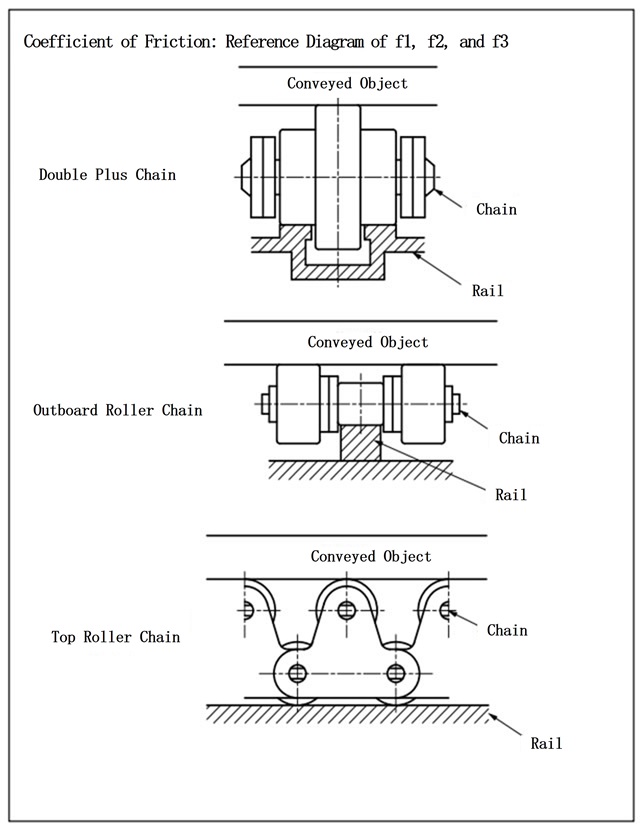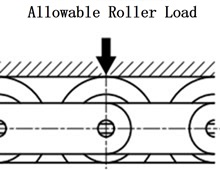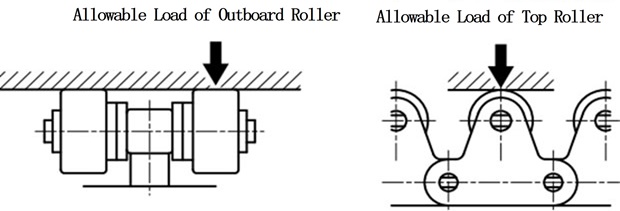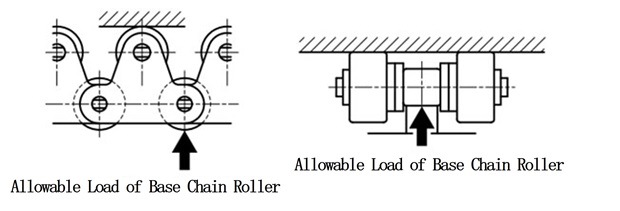Technical Data Small size conveyor chain Selection
To view selection procedures and precautions, please proceed to the following.
Click here to narrow down the product series or to make a tentative selection.
If you have specific conditions of use and wish to make a detailed selection, please click here.
Free flow chain selection
Steps 1. Check Conveyance Conditions
- (1)Type, mass, dimensions, and quantity of the conveyed objects (including pallet )
- (2)Conveying speed
- (3)Conveyor length (length of accumulating and conveying sections )
- (4)Atmosphere
Steps 2. Select Chain Type
Select the base chain and roller type according to the operating conditions and environment.
Steps 3. Tentatively Determine Chain Type
Perform tentative checking of chain load.
- SI Unit :F = 9.80665×WT × f × Kv/1000
- Gravity unit :F = WT × f × Kv
Note) In this catalog, values are indicated in both SI and gravimetric units.
The weight (kgf) used to calculate the max. load F in the gravimetric units is the same value as the mass (kg).
- F:Max. tension applied to chain kN {kgf}
- WT:Total mass of conveyed objects excluding chain kg
- f:Coefficient of friction f2(Table 8) + f3(Table 9)
- Kv:Speed coefficient (Table 13)
When two chains arranged in parallel are used, their working loads will be unequal.
Allowing for the imbalance of working loads, determine the model and size of a chain tentatively to ensure the maximum allowable load (Tables 14 and 15) of the chain is F×0.6 or more.
The maximum allowable load of small size conveyor chain (excluding stainless steel chain and engineering plastic chain*) is the value derived from the lowest fatigue limit.
When a load lower than this value is repetitively applied to the chain, fatigue failure will never occur.
※Stainless steel and engineered plastic chains: Maximum allowable load is determined from specifying the surface pressure between pins and bushes based on wear performance.
Table 7 f1:Coefficient of Friction Between Chain and Rail During Conveyance
| Chain type | Type of Base Chain Roller | No lube | With lube | |
|---|---|---|---|---|
| Double Plus Free Flow Chains | Plastic roller | A・B・C・D UA・UB |
0.08 | - |
| Steel roller | - | 0.05 | ||
| Center Roller Chains | Steel roller | - | 0.08 | |
| Outboard Roller Chain, Top Roller Chain | Steel roller |
S-roller | (0.21) | 0.14 |
| R-roller | (0.12) | 0.08 | ||
| Plastic roller | S-roller | - | - | |
| R-roller | 0.08 | - | ||
| Poly Steel Chain | - | 0.25 | - | |
( ) is for reference.
Table 8 f2:Coefficient of Friction Between Chain and Conveyed Objects During Accumulation
| Chain type | Transfer Roller | No lube | With lube |
|---|---|---|---|
| Double Plus Free Flow Chains | A・C・UA | 0.10 | - |
| B・D・UB | 0.15 | - | |
| Steel roller | - | 0.10 | |
| Center Roller Chains | Steel roller | - | 0.06 |
| Outboard Roller Chains | Plastic outboard roller | 0.06 | - |
| Plastic outboard rollers with brake | 0.20※ | - | |
| Steel outboard roller | (0.09) | 0.06 | |
| Top Roller Chains | Plastic top roller | 0.06 | - |
| Steel top roller | (0.09) | 0.06 |
( ) is for reference.

Note) Coefficient of friction for each outboard roller with plastic brake. When the number of brake outboard rollers accounts for about one third of the total number of outboard rollers, the coefficient of friction is 0.1.
(Refer to "Installation of Outboard Rollers" for RF double pitch and RS chain.
Table 9 f3:Coefficient of Friction Between Chain and Rail During Accumulation
| Chain type | Type of Base Chain Roller | No lube | With lube | |
|---|---|---|---|---|
| Double Plus Free Flow Chains | A・C・UA | 0.20 | - | |
| B・D・UB | 0.25 | - | ||
| Steel roller | - | 0.10 | ||
| Center Roller Chains | Steel roller | - | 0.10 | |
| Outboard Roller Chain, Top Roller Chain | Steel roller |
S-roller | (0.21) | 0.14 |
| R-roller | (0.12) | 0.08 | ||
| Plastic roller | S-roller | - | - | |
| R-roller | 0.08 | - | ||
| Poly Steel Chain | - | 0.25 | - | |
( ) is for reference.
Steps 4. Check Allowable Roller Load
Typical value that will not cause roller rotational failure, assuming use under lubricated conditions.
The load applied on the roller should not exceed the values given below. The values for steel rollers assume lubricated conditions.
1. Double Plus Free Flow Chains / Center Roller Chains

・RF2030 to RF2080
The values given below are the allowable conveying load per two strands of chain (allowable load per one meter of pallet).
Table 10 Roller allowable load
| Size | Type of Base Chain Roller | Frame | ||
|---|---|---|---|---|
| Aluminum frame | Aluminum Frame with Steel Rail |
|||
| RF2030 | Plastic roller | A・B・C・D | 0.39 {40} | 0.78 {80} |
| UA・UB | 0.20 {20} | 0.20 {20} | ||
| Steel roller | - | 1.57 {160} | ||
| RF2040 | Plastic roller | 0.59 {60} | 1.18 {120} | |
| Steel roller | - | 2.35 {240} | ||
| RF2050 | Plastic roller | 0.78 {80} | 1.57 {160} | |
| Steel roller | - | 3.14 {320} | ||
| RF2060 | Plastic roller | 0.98 {100} | 1.96 {200} | |
| Steel roller | - | 3.92 {400} | ||
| RF2080 | Plastic roller | - | 2.94 {300} | |
| Steel roller | - | 5.88 {600} | ||
2. Outboard Roller Chains / Top Roller Chains
Confirm the allowable loads of outboard rollers, top rollers, and base chain rollers.
1) Roller allowable load

Table 11 Roller allowable load
| Size | Outboard Roller and Single-Strand Top Roller | Double-Strand Top Roller | ||
|---|---|---|---|---|
| Plastic roller | Steel roller | Stainless steel roller | Steel roller | |
| RF2040・RS40 | 0.05 {5} | 0.15 {15} | 0.05 {5} | 0.29 {30} |
| RF2050・RS50 | 0.07 {7} | 0.20 {20} | 0.06 {6} | 0.39 {40} |
| RF2060・RS60 | 0.10 {10} | 0.29 {30} | 0.09 {9} | 0.59 {60} |
| RF2080・RS80 | 0.18 {18} | 0.54 {55} | 0.15 {15} | 1.08 {110} |
| RF2100・RS100 | 0.29 {30} | 0.78 {80} | 0.25 {25} | 1.57 {160} |
Note) The allowable load of Lambda rollers is the same as that of steel rollers.
2) Allowable Load of Base Chain Roller

Table 12 Allowable Load of Base Chain Roller
| Size | Steel roller | Plastic roller | Poly Steel Chain | Stainless steel roller | ||
|---|---|---|---|---|---|---|
| R-roller | S-roller | R-roller | R-roller | S-roller | ||
| RF2040・RS40 | 0.64 {65} | 0.15 {15} | 0.20 {20} | 0.02 {2} | 0.20 {20} | 0.05 {5} |
| RF2050・RS50 | 0.98 {100} | 0.20 {20} | 0.29 {30} | 0.04 {4} | 0.29 {30} | 0.06 {6} |
| RF2060・RS60 | 1.57 {160} | 0.29 {30} | 0.49 {50} | 0.06 {6} | 0.49 {50} | 0.09 {9} |
| RF2080・RS80 | 2.65 {270} | 0.54 {55} | 0.88 {90} | - | 0.78 {80} | 0.15 {15} |
| RF2100・RS100 | 3.92 {400} | 0.78 {80} | 1.27 {130} | - | 1.18 {120} | 0.25 {25} |
Note)
- 1. The above values for Poly Steel Chain represent the allowable load for each plastic inner link.
- 2. The allowable load of Lambda Chain is the same as that of steel roller chain.
- 3. The material used for steel R roller guide rail should be a high tensile strength material at least S45C (JIS), 1045 (AISI) or better.
- 4. The plastic roller includes heat-resistant type rollers (KV type).
Steps 5. Calculate Chain Load (F)

SI Unit
F =
G
1000
× {(W1 + M) × L1 × f1 + W2 × L2 × f2
+ (W2 + M) × L2 × f3 + 1.1 × M × (L1 + L2) × f1}
kW = F・V 60 × 1 η
Gravity unit
F = (W1 + M) × L1 × f1 + W2 × L2 × f2 + (W2 + M) × L2 × f3
+ 1.1 × M × (L1 + L2) × f1
kW = F・V 6120 × 1 η
- F:Max. tension applied to chain :kN{kgf}
- L1:Length of conveying portion :m
- W1:Mass of conveyed objects in conveying portion :kg/m
- L2:Length of accumulating portion :m
- W2:Mass of conveyed objects in accumulating portion :kg/m
- f1:Coefficient of friction between chain and rail during conveyance
- f2:Coefficient of friction between chain and conveyed objects during accumulation
- f3:Coefficient of friction between chain and rail during accumulation
- M:Mass of chain :kg/m
- kW:Power required :kW
- V:Chain speed :m/min
- η:Transmission efficiency of drive unit
- G:Gravitational acceleration :9.80665m/s2
Since the free flow conveyor uses two strands of chain generally laid in parallel, the chain mass is assumed to be that of two strands of chain. Consequently, "F" in the above formula represents the maximum chain load applied to two strands of chain.
Allowing for the imbalance of the working loads, it is assumed that a load of 0.6 F is applied to a single strand.
Steps 6. Determine Chain Size
Multiply the maximum load (0.6 F) applied to a single strand of chain by the speed coefficient (Kv) given in Table 13 for a chain that satisfies the following formula:
0.6F × Kv ≦ Max. Allowable Chain Load
The maximum allowable load of small size conveyor chain (excluding stainless steel chain and engineering plastic chain*) is the value derived from the lowest fatigue limit.
When a load lower than this value is repetitively applied to the chain, fatigue failure will never occur.
※Stainless steel and engineered plastic chains: Maximum allowable load is determined from specifying the surface pressure between pins and bushes based on wear performance.
Table 13 Speed coefficient (Kv)
| Chain speed m/min | Speed coefficient (Kv) |
|---|---|
| 15 or less | 1.0 |
| 15~30 | 1.2 |
| 30~50 | 1.4 |
| 50~70 | 1.6 |
| 70~90 | 2.2 |
| 90~110 | 2.8 |
| 110~120 | 3.2 |
The recommended speed of the following chains is as follows :
- Double Plus Chain : 5 to 15 m/min or less
- Plastic R roller chain : 70 m/min or less
- Poly Steel Chain : 70 m/min or less
Table 14 Maximum allowable load of the chain (1)
| Size & Roller type | Base Chain Type | Roller types | |
|---|---|---|---|
| A・C・UA | B・D・UB | ||
| RF2030VRP | Standard Series | 0.55 {56} | 0.27 {28} |
| HCP Series | |||
| Lambda Series | |||
| SS Series | 0.27 {28} | ||
| RF2040VRP | Standard Series | 0.88 {90} | 0.44 {45} |
| HCP Series | |||
| Lambda Series | |||
| SS Series | 0.44 {45} | ||
| RF2050VRP | Standard Series | 1.37 {140} | 0.69 {70} |
| HCP Series | |||
| Lambda Series | |||
| SS Series | 0.69 {70} | ||
| RF2060VRP | Standard Series | 2.06 {210} | 1.03 {105} |
| HCP Series | |||
| Lambda Series | |||
| SS Series | 1.03 {105} | ||
| RF2080VRP | Standard Series | 5.30 {540} | 2.65 {270} |
| HCP Series | |||
| Lambda Series | |||
| SS Series | 2.65 {270} | ||
| Size & Roller type | Base Chain Type | Roller types | |
|---|---|---|---|
| Steel (Double Plus Free Flow Chains ) |
Center Roller (Equal Speed ) |
||
| RF2030VR | Standard Series | 0.98 {100} | - |
| RF2040VR・CR | Standard Series | 1.57 {160} | 1.57 {160} |
| RF2050VR・CR | Standard Series | 2.45 {250} | 2.45 {250} |
| RF2060VR・CR | Standard Series | 3.73 {380} | 3.73 {380} |
| RF2080VR・CR | Standard Series | 5.30 {540} | 5.30 {540} |
Table 15 Maximum allowable load of the chain (2)
| Size | Chain type | ||||||
|---|---|---|---|---|---|---|---|
| Outboard Roller Chains | Single-Strand Top Roller Chain | ||||||
| Steel roller |
Plastic R Roller | Poly Steel Chain | Stainless steel roller |
Steel roller |
Plastic R Roller | Stainless steel roller |
|
| RF2040・RS40 | 2.65 {270} | 0.44 {45} | 0.44 {45} | 0.69 {70} | 2.65 {270} | 0.44 {45} | 0.69 {70} |
| RF2050・RS50 | 4.31 {440} | 0.69 {70} | 0.69 {70} | 1.03 {105} | 4.31 {440} | 0.69 {70} | 1.03 {105} |
| RF2060・RS60 | 6.28 {640} | 1.03 {105} | 0.88 {90} | 1.57 {160} | 6.28 {640} | 1.03 {105} | 1.57 {160} |
| RF2080・RS80 | 10.7 {1090} | 1.77 {180} | - | 2.65 {270} | 10.7 {1090} | 1.77 {180} | 2.65 {270} |
| RF2100 | 17.1 {1740} | 2.55 {260} | - | 2.55 {260} | 17.1 {1740} | 2.55 {260} | 2.55 {260} |
| RS100 | 3.82 {390} | 3.82 {390} | |||||
Note)
- 1. The allowable load of Lambda Chain is the same as that of steel roller chain.
- 2. The max. allowable load of double-strand top roller chain is 1.7 times that of single-strand top roller chain (1.4 times for Lambda Chain).

